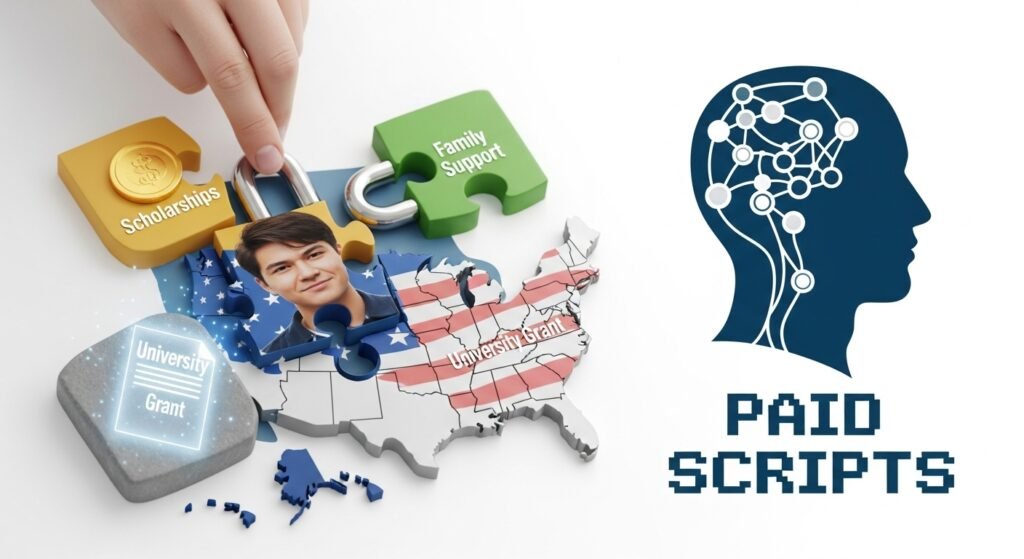That moment is unforgettable. You refresh your inbox for the hundredth time, and there it is: the subject line you’ve been waiting for. You click, your heart pounding, and the first word you see is “Congratulations.” Suddenly, it’s real. You’re going to study abroad in the USA.
You’ve probably already imagined it—the iconic campus quads, the stimulating lectures, the independence of navigating life in a new country. It’s a powerful dream, but the path to getting there can feel shrouded in mystery. Between complex forms, confusing deadlines, and daunting requirements, it’s easy to feel paralyzed before you even start.
I’ve navigated this journey firsthand and guided many others through it. This isn’t just another generic listicle. This is your strategic playbook. We’re going to demystify the entire process of applying to study abroad in USA programs, offering you the insider tips and clear direction you need for your 2025 application. Let’s turn that overwhelming maze into a straightforward map.

Why the U.S. Remains a Premier Destination for Global Scholars
Understanding the “why” fuels the “how.” The United States continues to attract students from every corner of the globe for some undeniable reasons:
- Academic Prestige and Choice: The U.S. boasts a concentration of the world’s top-ranked universities. More importantly, it offers an unparalleled diversity of programs. Whether you’re into astrobiology or arts management, you’ll find a program that fits. The emphasis on critical thinking and interdisciplinary study is a significant draw.
- Cultural Immersion: Choosing to study abroad in USA is about more than classes. It’s about immersing yourself in a cultural mosaic. You’ll gain a global network of friends and a perspective that employers value immensely.
- Career Catalyst: A U.S. degree is a powerful credential. The Optional Practical Training (OPT) program is a huge advantage, allowing you to gain work experience in your field for up to 12 months (or 36 months for STEM graduates) after your studies.
Your Step-by-Step 2025 Application Blueprint
The journey to study abroad in USA typically unfolds over a year. For a Fall 2025 intake, your time to start is now. Here’s your phased game plan.
Phase 1: The Discovery Phase (Starting Now – 12-18 Months Out)
This foundational stage is about deep research and honest self-assessment. Rushing this is the most common mistake applicants make.
1. Ask Yourself the Big Questions
Your journey to study abroad in USA must start with your own goals.
- Academic Fit: What do you genuinely want to study? Are you seeking a theoretical, research-heavy program or a practical, career-oriented curriculum?
- Campus Culture: Would you thrive in a massive, spirited state university or a small, discussion-based liberal arts college?
- Location & Lifestyle: Do you see yourself in the fast-paced energy of a metropolitan hub like New York, the tech-driven innovation of Silicon Valley, or a classic, self-contained college town?
- Budget Reality: Be brutally honest. Tuition and living costs vary wildly. Public universities often have lower tuition for state residents, but international students typically pay a higher rate.
2. Build Your Balanced University Shortlist (Aim for 8-12 Schools)
Your dream of a U.S. education shouldn’t rest on a single application. Create a strategic list:
- Reach Schools: Highly competitive institutions where your academic profile is slightly below the median admitted student.
- Target/Match Schools: Universities where your grades and test scores align strongly with the typical incoming class.
- Safety Schools: Institutions where your credentials are well above average, ensuring you have options.
Pro Tip: Use resources like the U.S. News & World Report rankings as a starting point, but dig much deeper. The best program to study abroad in USA for you is the one that aligns with your specific academic and personal needs. Look at faculty profiles, specific course offerings, and campus resources.
3. Conquer the Standardized Tests

Standardized tests are a key hurdle for most applications to study abroad in USA programs. Plan your timeline backward from your application deadlines.
- English Proficiency: You will almost certainly need to take the TOEFL iBT or IELTS. Confirm which one your chosen universities prefer. Most require a minimum score (e.g., TOEFL 80-100, IELTS 6.5-7.0).
- Undergraduate Exams: The SAT or ACT is required by most universities for freshman applicants.
- Graduate Exams: Prepare for the GRE (general and/or subject-specific) or the GMAT for business school.
Key Insight: While many schools have adopted test-optional policies, a strong score can still provide a significant boost to your application, especially for international students.

4. Launch Your Financial Strategy Early
Let’s be direct: a high-quality education to study abroad in USA is an investment. Begin your funding search immediately.
- University Scholarships: This is your most promising source. Most schools offer merit-based scholarships for international students. Scour the “International Admissions” and “Financial Aid” pages of every university on your list.
- Government and Home Country Sponsorships: Many countries offer scholarships for citizens to study abroad (e.g., the Fulbright Program, which is also for international students coming to the U.S.).
- External Funding: Look into organizations like the World Bank, the AAUW (for women), and private foundations that offer international scholarships.
| Funding Source | What It Is | Who It’s For |
|---|---|---|
| University Merit Aid | Scholarships awarded for academic excellence | High-achieving students with strong grades/test scores |
| Home Country Sponsorships | Grants from your government or local organizations | Students committed to returning home after studies |
| Private Scholarships | Awards from corporations, NGOs, and trusts | All students, but often highly specialized and competitive |
Phase 2: The Application Engine (9-12 Months Before)
This is where you assemble your narrative and gather your proof.
5. Transcripts and Credential Evaluation
You will need official copies of your academic transcripts. Most U.S. universities require these documents to be translated (if necessary) and evaluated by a credential evaluation service like World Education Services (WES) or Educational Credential Evaluators (ECE). This process verifies your academic equivalency and can take several weeks, so initiate it early.
6. Craft Your Story: The Personal Essay
This is your single greatest opportunity to speak directly to the admissions committee. It’s not a resume in paragraph form.
- Show, Don’t Tell: Instead of saying “I’m a leader,” describe a specific time you mobilized a team to solve a problem.
- Be Specific: Why this specific program to study abroad in USA? Name a professor whose work inspires you or a unique lab you want to work in. Generic statements are easily spotted and dismissed.
- Connect the Dots: How have your past experiences led you to this field of study? What will you contribute to the campus community?
7. Secure Powerful Letters of Recommendation (LORs)
Choose recommenders who know you well—a professor who supervised your thesis, a manager from a relevant internship. A detailed letter from a direct supervisor is far more powerful than a generic one from a high-ranking official who doesn’t know your work.
- Make it easy for them: Provide them with your resume, a draft of your personal statement, and a clear list of deadlines.

8. Showcase a Well-Rounded You
U.S. admissions committees look for passionate, engaged individuals. Your involvement in clubs, sports, volunteer work, internships, or personal projects demonstrates soft skills like leadership, teamwork, and time management. Document your roles and key achievements clearly.
Phase 3: Submission Season ( deadlines)
9. Respect the Deadlines Religiously
This is non-negotiable. The process to study abroad in USA runs on a strict schedule.
- Early Decision/Action (Typically Nov. 1/15): ED is binding; if accepted, you must attend. EA is non-binding. Applying early can sometimes improve your odds.
- Regular Decision (Typically Jan. 1/15): The standard application deadline for most schools.
- Rolling Admission: Applications are reviewed as they are received. For these, the earlier you apply, the better.
Pro Tip: Most undergraduate programs use the Common Application or Coalition Application, allowing you to apply to multiple schools with one form. Graduate applications are usually school-specific.
Phase 4: The Final Stretch (Post-Acceptance)
10. Navigating the I-20 and F-1 Student Visa
Once you accept an offer, your university will issue you a Form I-20, your certificate of eligibility for a student visa.
- Pay the SEVIS I-901 Fee: This mandatory fee funds the Student and Exchange Visitor Information System.
- Complete the DS-160 Form: This is your online nonimmigrant visa application.
- Prepare for Your Visa Interview: This is a crucial step. Be ready to convincingly demonstrate your academic intent, financial ability to pay for your studies, and strong ties to your home country that will ensure your return after your program.
11. Pre-Departure Preparation
- Health Insurance: Most universities require it. Secure a plan that meets their standards.
- Housing: Apply for on-campus housing as soon as the portal opens, or start researching off-campus options.
- Finances: Understand how you’ll manage your money. Set up a U.S. bank account upon arrival.

Your American Academic Journey Awaits
The path to study abroad in USA is detailed, but it is absolutely achievable with meticulous planning, organization, and a dose of courage. It’s a process that, in itself, teaches you invaluable skills in project management and perseverance.
View each step not as a hurdle, but as a milestone. The effort you invest now will pay dividends in the form of an transformative educational experience that will shape your worldview and your future.
Your first step is the most important one. Which part of the process are you most curious or nervous about? Share your questions in the comments below, or connect with our community of future international students for advice and support. Your journey to study abroad in USA starts today




Pingback: UK Student Visa Requirements 2025 - PaidScripts -Tech Education Hub: Courses & Student Resources
Pingback: Are Online Degrees Worth It in 2025 - PaidScripts -Tech Education Hub: Courses & Student Resources
Pingback: How to Start Online Tutoring in 2025 — Earn from Home - PaidScripts -Tech Education Hub: Courses & Student Resources
Pingback: Manage Student Loans with Online Learning Tips - PaidScripts -Tech Education Hub: Courses & Student Resources
Pingback: Top 10 Free Online English Courses with Certificates in 2025 - PaidScripts -Tech Education Hub: Courses & Student Resources
Pingback: Essential Climate Change Education for Students - PaidScripts -Tech Education Hub: Courses & Student Resources